15 Ceremonies and Socials
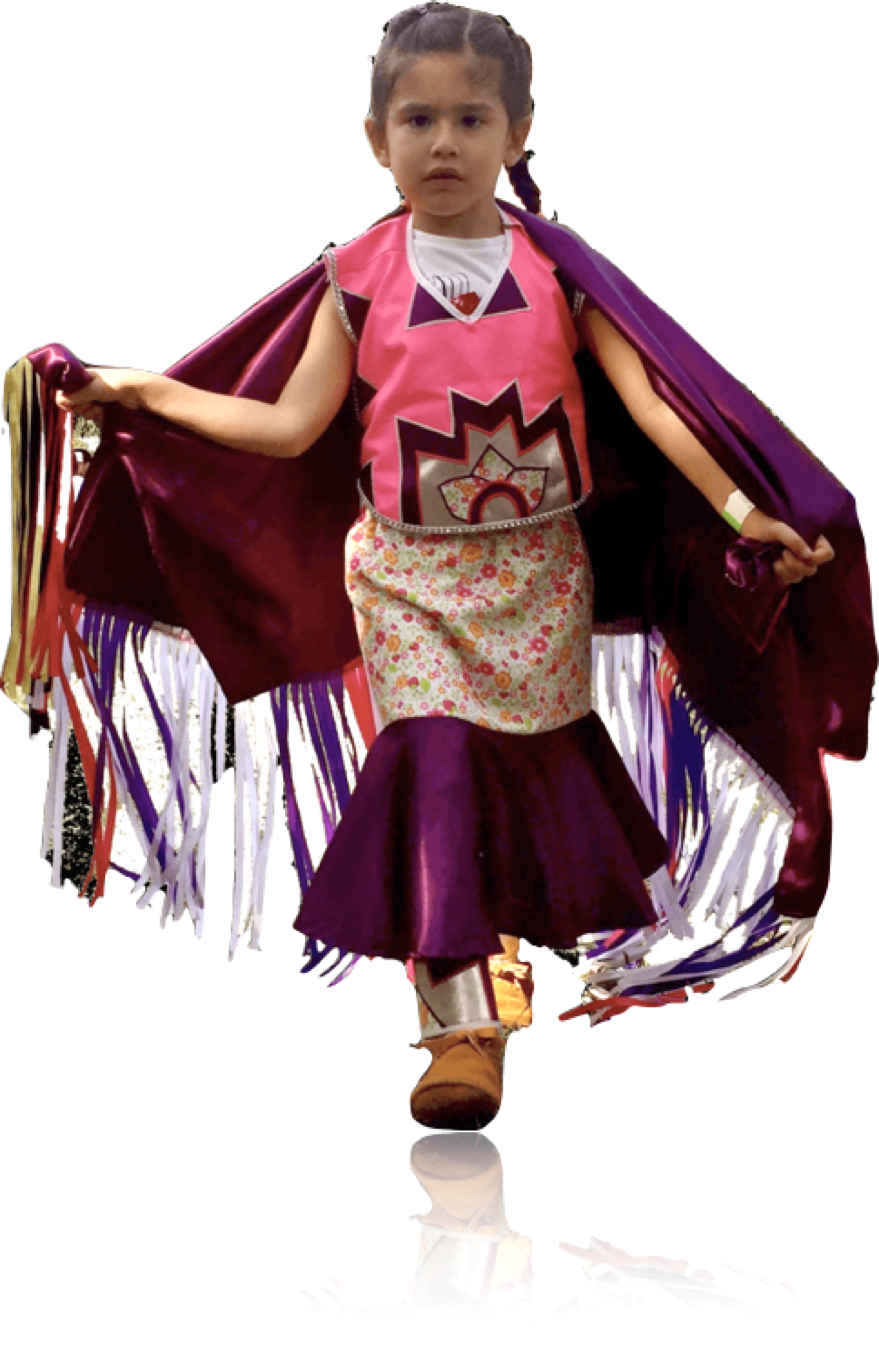
The Indigenous Peoples of Turtle Island are far more diverse than is usually represented in the media; it is very important to keep in mind that each community, Nation, and clan has customs that are specific to it. This gallery will help familiarize you with some of the ceremonies and socials that are common to many Indigenous communities.
It is also important to recognize that since all of these ceremonies and socials were illegal under the Indian Act in Canada (the “cultural ban,” which ended in 1951), Indigenous Peoples and all Canadians owe a debt of gratitude to those who took risks to preserve vital cultural knowledge for future generations. Many communities are still relearning and rediscovering their traditions.
Gallery 3.1 Ceremonies and socials
Feasts and giveaways
Feasting is an important cultural ceremony that occurs throughout the year for different reasons; a feast can be an occasion for giving thanks (to the Creator, to ancestors, or to someone in the community). Feasts often occur after ceremonies; for instance, at the end of the day at a powwow. Like all important cultural practices, feasts begin with tobacco, and often smudging occurs beforehand. Sometimes there are specific practices and protocols during the feast, such as younger people preparing food for and serving older people and/or elders. Traditional foods are served at feasts – in North America, these include (depending on the region) “three sisters” (corn, beans, and squash), wild rice, fish, berries, bannock, and wild meat (Anishnawbe Health Toronto, n.d.-a).
Naming ceremonies
Most Indigenous communities have naming ceremonies, but each has its own practice that differs in terms of when and how the ceremony happens – for example, at a particular age or in a particular season. Many Indigenous Peoples have both a legal name and a traditional name (called a “spirit name” in some traditions). Sometimes names are given at birth. The ceremony leader may also identify colours of significance to the child, in the Indigenous language of their ancestors (if possible). In other communities, names are given in adulthood. Names may be related to a person’s clan, and might be a name previously carried by an ancestor (Sandy Lake First Nation, n.d.).
Sweat lodges
Sweat lodges are purification and healing ceremonies, and can be held for different reasons. They are led by Indigenous people with specialized traditional knowledge of the ceremony, and usually involve a day-long process of building, preparing, and participating in the sweat lodge. Sweat lodges are often followed by a feast. In the lodge, which is a dome or tent made of natural materials (wood, bark, cedar, and the like), there is a pit in the centre where hot rocks are placed, and water is poured over them to make steam. Women traditionally wear long skirts (in some traditions, these are ribbon skirts), and sweat lodges are often held for either men or women (Sandy Lake First Nation, n.d.).
Moon time
In most Indigenous cultural practices, there are special protocols for women when they are in their moon time (have their menstrual period). During this time, women are considered powerful, because moon time is a sign that women can give life. During her moon time, a woman does not handle sacred items or medicine, or take part in ceremony. It is a time of rest, and in some communities, male relatives take on chores and work so that the woman can use this time to rejuvenate. It is taught that Grandmother Moon watches over the moon cycles, and that women can ask Grandmother Moon for guidance and healing at this time. A full moon ceremony, often involving water, may take place during this time of the month (Anishnawbe Health Toronto, n.d.-b).
Strawberry/spring berry ceremonies
“The strawberry teaches forgiveness and peace. The strawberry is shaped like a heart, and strawberries are known to our people as hear berries.” –Elder Lillian Pitawanakwat
Just as the strawberry is connected to the earth by leaves and roots, the heart is connected to the rest of the human body. Strawberry ceremonies, and feasts, are held in many communities in June during the lunar moon, which is called the “strawberry moon” by many Indigenous Peoples. Strawberries, both the leaves and the fruit, are an excellent source of vitamin C, and the plant is considered women’s medicine. In many Nations, when a girl gets her first moon time, she refrains from eating berries for a year, and at the completion of the year, a strawberry feast is held for her. Teachings about love, community, and creation are tied to the strawberry.
Métis “rendez-vous”
A traditional gathering for the Métis is called a rendez-vous, which comes from the French term for “meeting.” At a rendez-vous, Métis get together for fiddling, music, dance (e.g., the Red River jig), traditional arts such as finger weaving, and traditional food. Métis culture is unique, influenced by both Indigenous and French traditions and resulting in a language (Michif), practices, and protocols that are passed down from one generation to the next through celebrations like the rendez-vous. Sometimes, a rendez-vous or other Métis tradition, like fiddling, is included in powwows or other ceremonies and socials, since Indigenous Peoples recognize all their relations and are inclusive of one another.
Potlatch ceremonies
Indigenous communities on the Pacific Coast celebrate through potlatch ceremonies. In Kwakwala, one of the coastal languages, potlatch means “to give.” While Western societies associate wealth and power with how many possessions and how much money someone has, the West Coast Nations recognize a wealthy, high-status person by how much they have been able to give away in their life. Gifts that hold special significance include copper and songs. Potlatches can be held to celebrate or to rekindle relationships with non-human relations, to give thanks, to mourn the passing of a loved one, or as part of rites of passage, like marriage or naming ceremonies. The guests of a potlatch receive many gifts; in the past, useful household items, blankets, or food were often distributed. Potlatches were historically hosted in a “big house,” a large wood building in a coastal village.
Resistance and Resilience in Modern Powwow
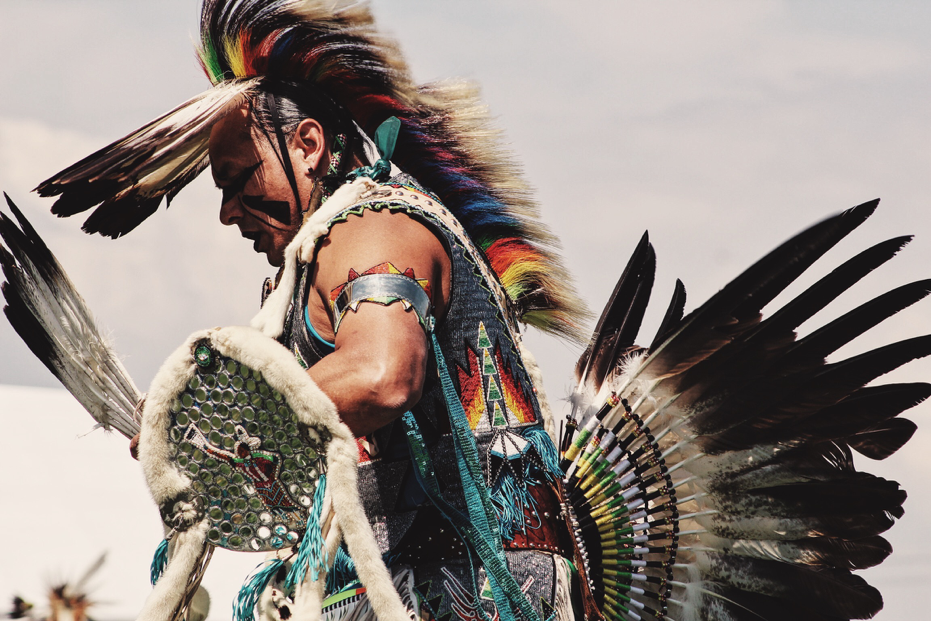
The aroma of burning sage drifts through the air as the Drum beckons dancers into the arena. Warriors with bustles of eagle feathers, elaborate beadwork, and painted faces dance stories of battles and hunts. Silver cones made from snuff can lids clink brightly in time on a Jingle Dress as women dance prayers for healing. Swirls of fringe, wisps of ribbons, flashes of mirrors … more dance styles, so much to see. This is powwow!
For thousands of years, Nations on Turtle Island varied in language, tradition, belief, and dress, but still gathered socially to trade, dance, sing, compete in games and sports, see healers, feast, and hold ceremony. Gatherings also solidified social and political ties, allowed young people to marry into other Nations, and fostered the flow of innovations and exchange traditions.
Non-Indigenous people might perceive powwow as a cultural festival where First Nation Peoples of Turtle Island come together to dance, sing, feast, shop, and trade, make new friends, and reconnect with long-time friends and family. But the fact that Indigenous Peoples still gather and dance is itself an act of resilience. Beneath the colourful pageantry and spectacle of the modern powwow, layers of personal significance, acts of resistance, and spiritual meaning lie hidden in plain sight.
Indigenous Peoples and Cultural Embodiment Through Dance
For Indigenous Peoples “the ability to dance – to pray using motion – is a gift to Natives from the Creator” (Browner, 2004, p. 49). Throughout the settlement of the United States and Canada, people indigenous to this continent experienced waves of devastation including loss of land and way of life, removal from home territories on to reservations, and the discriminatory practices of governments that sought to fix the “Indian problem” through laws prohibiting ceremonies and mandatory residential schools with the goal of forced assimilation. Ultra-conservative views on how to “civilize” First Nation Peoples through Christianity, education, and hard labour were part of the Victorian Era and still exist to this day. Indigenous dancing was loathed and feared, especially by Christians who believed the fabricated accounts of missionaries who spoke of devil conjuring and orgies at the dances and ceremonies, despite the fact they had not actually witnessed the dances themselves (Shea Murphy, 2007, p. 33). Shea Murphy says, “Praying through bodily movement and ritual practice rather than through sitting, reading, and believing threatened colonizers’ notion of how spirituality is manifested” (p. 31). Laubin & Laubin (1977) explain that the governments understood that “dancing was the most Indian thing about Indians” and that by outlawing dance, “with one blow, the entire social, political, and religious life of a tribe could be crushed” (p. 81).
Indigenous Dances Outlawed
In 1883 Hiriam Price, a devout Christian, was appointed as Indian Commissioner in the United States. The first Indian offense named in his issued Rules for Indian Courts is dancing. His restriction on dancing is outlined as follows:
Gallery 3.2 Historical powwow photographs
Under the Indian Act, powwows and other gatherings were banned or required consent of the Indian Agent. The Kainai were required to receive written permission to leave the reserve and were only allowed to return to Banff National Park during “Indian Days.”
During the first half of the 1900s, the cultural ban (under the Indian Act) made all First Nations cultural practices illegal in Canada. The exception to this was ‘Indian Days’, which ran yearly from 1910 to 1972. During this festival, which was set up to encourage tourism in the area, the Stoney people were permitted back into their traditional territories within Banff National Park. Indigenous people were encouraged to ‘dress up’ and entertain tourists.
3. (a). Any Indian who shall engage in the sun dance, scalp dance, war dance, or any other similar feast, so called, shall be deemed guilty of an offense, and upon conviction thereof shall be punished for the first offense by the withholding of his rations for not exceeding ten days or by imprisonment for not exceeding ten days; and for any subsequent offense under this clause he shall be punished by withholding his rations for not less than ten nor more than 30 days, or by imprisonment for not less than one nor more than thirty days. (Prucha, 1990, p. 187)
In 1876 Canada introduced the Indian Act with the intention of forcing assimilation. It restricted the freedom of Indigenous Peoples to conduct spiritual ceremonies and live their culture including wearing traditional clothing. Shea Murphy (2007) recounts legislation introduced to the House of Commons that came into effect in 1885. Section 114 in the Revised Statutes of Canada reads:
1. Every Indian or person who engages in or assists in celebrating the Indian festival known as the “Potlatch” or the Indian dance known as the “Tamanawas,” is guilty of a misdemeanor, and liable to imprisonment for a term not exceeding six months and not less than two months.
2. Every Indian or person who encourages, either directly or indirectly, an Indian to get up such a festival or dance, or to celebrate the same, or who assists in the celebration of the same, is guilty of a like offense, and shall be liable to the same punishment. (p. 39)
Indian agents were instructed to use whatever means necessary to enforce dance restrictions. As a result, there are numerous accounts of violence and cruelty against Indigenous Peoples who were imprisoned for dancing, such as corporeal discipline, withholding rations from their families, cutting their long hair, keeping them hungry or without sleep, and forcing them to wear Western clothing (Shea Murphy, 2007, p. 43).
Indigenous dance on a reserve was not permissible, but staging Indigenous dance to entertain white audiences at festivals, parades, and other patriotic events was both expected and quite popular. McNenly (2012) says such performances “gave Native performers socially viable ways of maintaining and expressing their culture and identity” and was often the only legal times they could dance or wear traditional clothing without being imprisoned (p. 79).
The Romantic Myth of the “Noble Savage”
While the governments were penning laws against Indigenous dancing, a sense of nostalgia for the “vanishing race” was also growing. The Eastern United States had been out of contact with First Peoples since their annihilation and forced removal to lands east of the Mississippi River. Moses (1996) says, “The belief that they were the Vanishing Americans doomed to extinction by the march of civilization became the most romantic of all impressions associated with Indians” (p. 13). The distance in space and time separating settlers from the frontier created the romantic idea of the “noble savage.” Berkhofer (1978) notes that “if Whites regarded the Indian as a threat to life and morals when alive, they regarded him with nostalgia upon his demise – or when that threat was safely past” (p. 29). This attitude created interest in and opportunity for the Wild West shows of the 1880s.
Gallery 3.3 “Noble Savages” characters
Wild West Shows and Influence on Modern Powwows
The same year the Sun Dance ceremony was outlawed, Buffalo Bill Cody hired 36 Pawnee from Indian Territory as his first “Show Indians.” He saw the opportunity to capitalize on the white audiences’ desire to have an “authentic” experience of the West and see performers who were living pieces of history. Shea Murphy (2007) explains:
By staging these dances, transposed to a performance arena supposedly devoid of actual danger, Cody quite literally performed Indian dances’ powerful effects as contained and conscripted, rousing – and then assuaging – non-Natives viewers’ anxieties and fears of attack and replacing them with fascination and titillation at a safe distance. (p. 75).
Gallery 3.4 Wild West Shows
Buffalo Bill’s Wild West Show, other similar western shows, and advertisements for these spectacles established the Plains cultures as representative of all First Nation Peoples. Shea Murphy (2007) explains that the resulting stereotype “codifies and prescribes a performance of ‘Indian’ (which in the Wild West meant Plains Indian, complete with headdresses and horses) as a universalized prototypical American Indian, despite the diversity of Native peoples from the continent” (p. 63). If Buffalo Bill had toured Pueblo or Woodland cultures instead, our ideas and stereotypes about First Peoples would be much different today.
White audiences attending Wild West shows expected to see a performance of “Indianness” that had been fabricated through years of government and religious propaganda. Initially they were disappointed by the display of real Pawnee dancing because it did not live up to their visions of “war dancing savages.” Buffalo Bill thought his show would be more successful if the dances and regalia were more dramatic and theatrical, so he asked the dancers to “fancy up” their outfits and movements. The men added a second feathered dance bustle to their regalia and incorporated more turns and athletic steps into their dances. This new fabricated dance style was purely for audience entertainment and fit more closely with white fantasies of Indian dance (Browner, 2004, p. 30). This new style became the basis for the men’s fancy bustle dance still seen at contemporary powwows. Wild West shows also gave powwow the opening processional known as “Grand Entry” as well as competitions and exhibition dancing.
Legalization of Indigenous Dance
As time passed, Wild West shows died out, and eventually attitudes towards Indigenous Peoples began to change. In 1933 John Collier was appointed Indian Commissioner in the United States. Collier held a more romantic idea about the importance of preserving First Nations’ culture as a living tradition, and he legalized dancing for religious purposes. In 1934 a Lakota woman named Brings Home a Blue Horse said, “When they stopped our dancing we died. We stopped living. We felt there was nothing left to live for. Now we can dance again and it brings sunshine into our hearts. We feel j-u-s-t good!” (Laubin & Laubin, 1977, p. 81).
In Canada, however, dance restrictions remained on the books until the 1951 amendment to the Indian Act, which finally allowed First Nations to conduct ceremonies and celebrations, including powwows, without interference from federal agents. In practice, this amendment took some time to be accepted and permission was often left to the discretion of the Indian agents. Participating in dances and ceremonies was “discouraged” for over 100 years, and outlawed in Canada for 66 years. Those years of repression caused unfathomable loss of cultural, spiritual, and ceremonial knowledge, which had been developed over thousands of years and passed down through generations. By the 1950s government and church attempts at assimilation, discriminatory laws, and abuse in residential schools had left many people personally shattered, ashamed of their culture, and completely disconnected from traditions. Many Indigenous Peoples were apprehensive about rekindling ceremonies or holding dances because of previous experiences of imprisonment.
Reclaiming Indigenous Identity Through Powwow
The legalization of religious dance transformed Indigenous gatherings. No longer held for the purpose of entertaining white audiences, inter-tribal powwows grew and served as homecoming celebrations for First Nation veterans after World War II. The Civil Rights Movement of the 1960s and subsequent reclamation of Indigenous rights by the American Indian Movement (AIM) caused a resurgence in pride and culture; subsequently, powwows boomed across North America. Moses (1996) says, “In the case of the powwow, it also became a means by which people could retain, restore, or, in certain instances, create through adaptation a modern Indian identity” (p. 272). Powwow gave Indigenous Peoples a way to reclaim themselves.
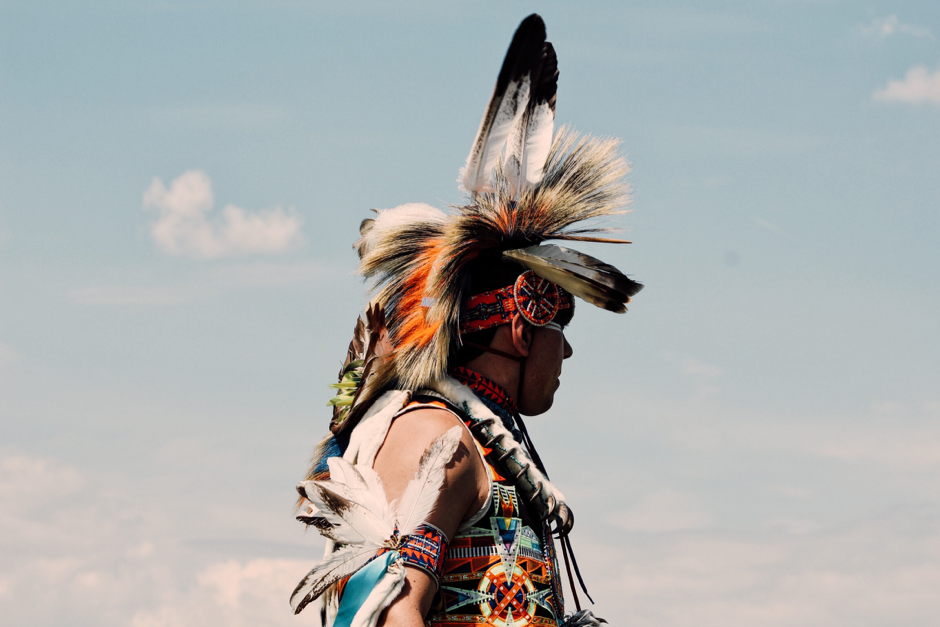
In the 1970s and 1980s some Indigenous Peoples feared that powwow would cause a melting together of individual tribal identities into one pan-Indian culture. However, the opposite is true of powwow as an intertribal gathering. Powwow functions to inspire the process of historical and cultural reclamation by revitalizing hidden and dormant traditions. Cook, Johns, and Wood (2005) give an example: “while the use of Plains-style regalia dominates many powwows, movement is growing in the Eastern United States toward the use of Eastern Woodland styles that are tribally specific when possible” (p. 215). Toelken (1991) describes powwow today as “essentially a social gathering at which Indian people from several different tribes dance together, using a few basic patterns that all the tribes recognize” (p. 139).
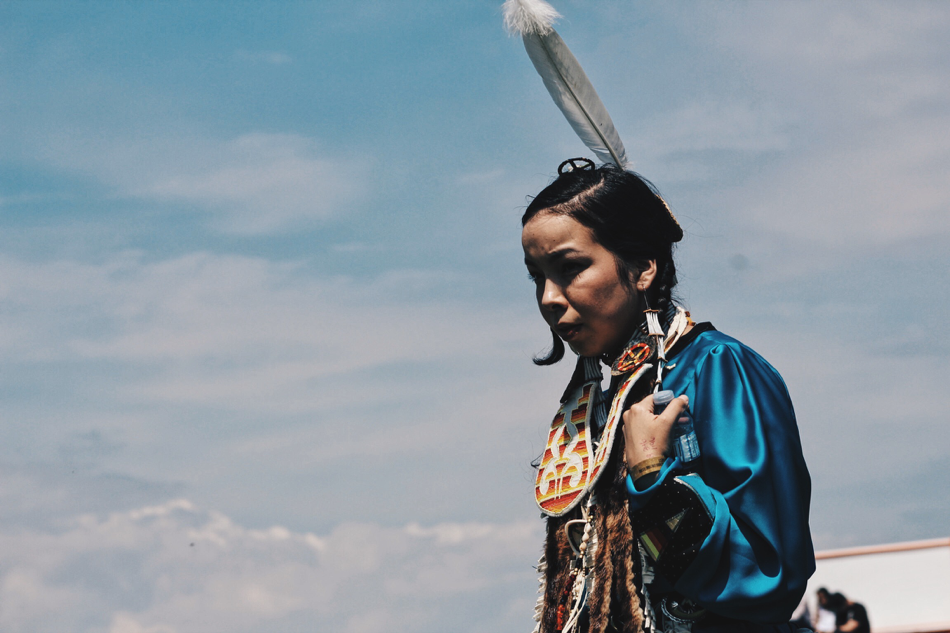
Another role powwows play in contemporary Indigenous culture is offering a safe and inviting, social way for people who have been separated from their heritage to return to the culture. Assimilation practices such as the Sixties Scoop, residential schools, and forced adoptions, and many other situations have left generations of Indigenous people struggling to reclaim their culture and identity. Moses (1996) agrees, saying, “The powwow especially, an institution of inter-tribal ceremonialism and celebration, became both an evocation of culture as a means of creating an adaptive culture for those Indian nations long separated from their landed heritage” (p. 275). Toelken (1991) tells us that what Indigenous people “have done with powwow is to intensify and solidify an occasion through which they can celebrate the continued existence of Indian ways of life” (p. 155). Shea Murphy (2007) says powwow dancing not only affirms community, but powwow also becomes a space to “access and negotiate a contemporary, ever changing relationship to Indian identity” (p. 77). Participation in ritual and ceremony as part of powwow feeds the souls of Indigenous people, helps soothe the longing for connection and community, and helps to fill the void created by colonization.
Blending Spiritual and Secular
Indigenous cultures have always blended the spiritual and secular. Powers (1990) notes that there is not much difference between songs sung for ceremony and songs for secular events; the difference is contextual rather than structural, “thus a sacred song may open a powwow, and a secular song may be sung for the amusement of supernatural spirits at a religious meeting” (p. 52). Browner (2004) says, “It often seems as if Indian participants move in a reality set off from non-Indian observers who tend to perceive pow-wow as a combination carnival and sporting event” (p. 35). She continues, “These differing sensibilities enable Indians to perform dances that, although in a commercial setting, have profound spiritual meaning for them” (p. 35).
Regalia and Eagle Feathers
Dance attire is referred to as an outfit or regalia, never a “costume”: wearing a costume like a child at Halloween is pretending to be someone or something else, whereas powwow regalia honours tradition and a community’s ancestors, and it represents who Indigenous Peoples are. Some designs are specific to spirit names and clans. It takes a long time to hand-make regalia, and each outfit is a unique representation of the dancer. It is important not to touch a dancer’s hair or regalia without permission, and it is polite to ask before taking photographs.
Eagle Feathers that adorn a dancer’s hair and that are carried in fans and bustles hold tremendous significance to most First Nation Peoples. Anishinaabe cosmology says the Eagle intervened on behalf of human beings and saved them from being destroyed. The Eagle is the highest-flying bird in North America and as he circles up into the sky, he carries our prayers to the Creator. It is a great honour to receive an Eagle Feather as a recognition of accomplishments because it has been high in the presence of the Creator. Because the feather stayed behind when the eagle went to the spirit world, each feather has spirit and is treated with honour and respect through feasting and smudging. Dancers take special care to make sure their Eagle Feathers never touch the ground. If an Eagle Feather should happen to fall during powwow, he is regarded as a fallen warrior and a special ceremony with four veterans takes place to retrieve him.
Mainstream stereotyping and judgments regarding how Indigenous Peoples are expected to look and act are examples of how the Wild West shows are still misshaping perception. Berkhofer (1978) says, “In spite of centuries of contact and the changed conditions of Native American lives, Whites picture the ‘real’ Indian as the one before contact or during the early period of that contact” (p. 28). He also wonders if white people don’t “conceive of themselves as still living as Anglo-Saxons, Gauls, or Teutons, then why should they expect Indians to be unchanged from aboriginal times” (Berkhofer, 1978, p. 29). Culture is not static, and wearing contemporary fashions or using new materials in regalia is part of First Peoples’ tradition of innovation.
Interactive 3.6 Ribbon skirts: Interview with Harmony Nadjiwon
Anishinaabe designer Harmony Nadjiwon discusses ribbon skirts.
Conclusion
Indigenous gatherings that included song, dance, and feasting existed thousands of years before European contact. Understanding Indigenous world view creates a greater appreciation for the spiritual beliefs and protocols taking place in plain sight but also beyond a spectator’s experience. The history of injustice that Indigenous Peoples have survived and endured make the fact that powwow exists and that Indigenous Peoples still dance an act of resistance and resilience.
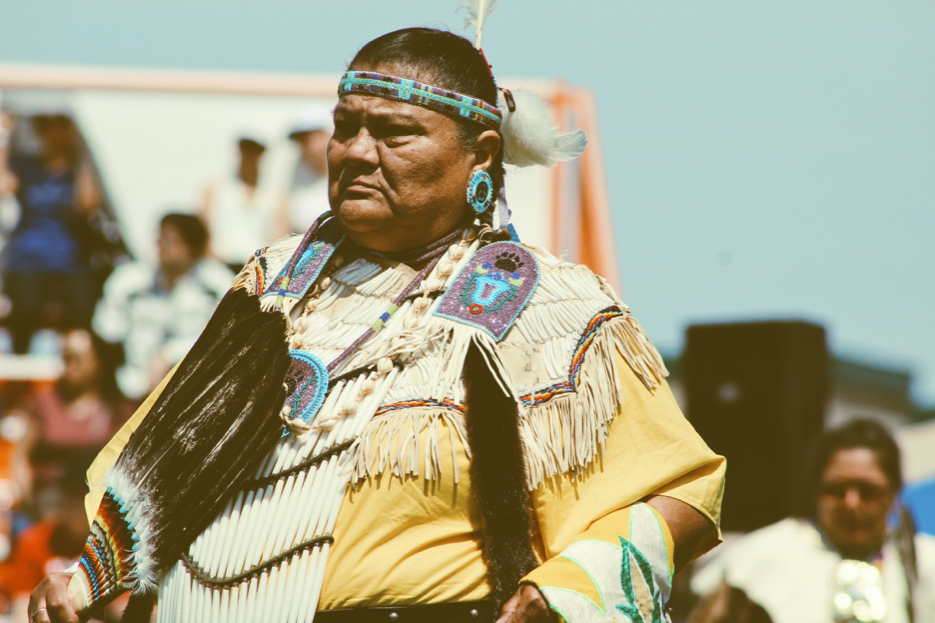
References
Anishnawbe Health Toronto. (n.d.-a). Teachings: Feasts and giveaways [Brochure]. Retrieved from http://aht.ca/images/stories/TEACHINGS/Giveaways.pdf
Anishnawbe Health Toronto. (n.d.-b). Teachings: Moontime [Brochure]. Retrieved from http://aht.ca/images/stories/TEACHINGS/Moontime.pdf
Anishnawbe Health Toronto. (n.d.-c). Teachings: Names and colours [Brochure]. Retrieved from http://aht.ca/images/stories/TEACHINGS/Name_and_Colours.pdf
APTN National News. (2017, January 17). The Sundance Ceremony Part 1. Retrieved from http://aptnnews.ca/2013/08/14/the-sun-dance-ceremony/
Berkhofer, R. F. (1978). The white man’s Indian: Images of the American Indian from Columbus to the present (1st ed. –.). New York: Knopf.
Browner, T. (2004). Heartbeat of the people: Music and dance of the northern pow-wow (1st pbk. ed.). Urbana: University of Illinois Press.
Cook, S. R., Johns, J. L., & Wood, K. (2005). The Monacan Nation powwow: Symbols of Indigenous survival and resistance in the tobacco row mountains. In C. Ellis, L. E. Lassiter, & G. H. Dunham (Eds.), Powwow (pp. 201-223). Lincoln, NE: University of Nebraska Press.
Imaging, S. A., & U’mista Cultural Society. (n.d.). Potlatch. Living Tradition: The Kwakwaka’wakw Potlatch on the Northwest Coast. Retrieved from https://umistapotlatch.ca/potlatch-eng.php
Joseph, B. (n.d.). Potlatch ban: Abolishment of First Nations ceremonies. Indigenous Corporate Training Inc. Retrieved from https://www.ictinc.ca/the-potlatch-ban-abolishment-of-first-nations-ceremonies
Laubin, R., & Laubin, G. (1977). Indian dances of North America: Their importance to Indian life. Norman: University of Oklahoma Press.
Madison, D. S. (2012). Critical ethnography: Methods, ethics, and performance. Thousand Oaks, CA: Sage Publications.
McNenly, L. S. (2012). Native performers in wild west shows: From Buffalo Bill to Euro Disney. Norman, OK: University of Oklahoma Press.
Métis Nation of Ontario. (n.d.). Rendezvous throughout the Nation. Retrieved from http://www.metisnation.org/programs/health-wellness/rendezvous/
Monkman, L. (2017, March 25). How a historical ban on spirituality is still felt by Indigenous women today. CBC News. Retrieved from http://www.cbc.ca/news/indigenous/historical-ban-spirituality-felt-indigenous-women-today-1.4036528
Moses, L. G. 1. (1996). Wild West shows and the images of American Indians, 1883-1933. Albuquerque: University of New Mexico Press.
Pitawanakwat, L. (2006, June 10). Ojibwe/Powawatomi (Anishinabe) teaching. Four Directions Teachings.com. Retrieved from http://www.fourdirectionsteachings.com/transcripts/ojibwe.html
Potlatch – First Nations in B.C. (n.d.). Royal British Columbia Museum. Retrieved from https://royalbcmuseum.bc.ca/exhibits/bc-archives-time-machine/galler07/frames/potlatch.htm
Powers, W. K. (1990). War dance: Plains Indian musical performance. Tucson: University of Arizona Press.
Prucha, F. P. (1990). Documents of the United States Indian policy (2nd ed.). Lincoln: University of Nebraska Press. p. 160.
Sandy Lake First Nation. (n.d.). Traditions and culture. Retrieved from http://sandylake.firstnation.ca/?q=traditions-and-culture
Shea Murphy, J. (2007). The people have never stopped dancing: Native American modern dance histories. Minneapolis: University of Minnesota Press.
Simon Fraser University. (n.d.). The potlatch ban. Retrieved from https://www.sfu.ca/brc/online_exhibits/masks-2-0/the-potlatch-ban.html
Strawberry teachings. (n.d.). Curve Lake First Nation: Newsletter. Retrieved from https://www.curvelakefirstnation.ca/newsletters/Strawberry-Teachings.pdf
Toelken, B. (1991). Ethnic selection and intensification in the Native American powwow. In S. Stern & J. A. Cicala (Eds.), Creative ethnicity: Symbols and strategies of contemporary ethnic life (pp. 137-156). Logan: Utah State University Press.
Media (in order of appearance)
Bowl with decorative gourds and corn [photograph]. (2018, February 15). Retrieved from https://pxhere.com/en/photo/1422591
Robertson, D.G.E. [photographer]. (2011, July 30). Frame for sweat lodge at Lake Superior Provincial Park, Wawa, Ontario, Canada [photograph]. Retrieved from https://commons.wikimedia.org/wiki/File:Sweat_lodge_at_Lake_Superior_PP.jpg
Gil, M. [photographer]. (2010, March 30). Howling at the Moon [photograph]. Retrieved from https://commons.wikimedia.org/wiki/File:Howling_at_the_Moon_in_Mississauga.jpg
Youngson, N. [photographer]. (2015, July). Strawberries [photograph]. Retrieved from http://www.picserver.org/s/strawberries.html
Métis ‘rendez-vous’ [photograph]. (2016). Retrieved from https://saugeenmetis.com/wp-content/uploads/2016/11/IMG_2733.jpg
Curtis, E.S. (1915). The North American Indian (1907-1930) v.10, The Kwakiutl. ([Seattle] : E.S. Curtis ; [Cambridge, Mass. : The University Press], 1915), plate no. 358. Digital ID: cp10030. Northwestern University Digital Collection, Evanston, IL. Retrieved from http://curtis.library.northwestern.edu/curtis/viewPage.cgi?showp=1&size=2&id=nai.10.port.00000031.p&volume=10
Toohey, J. (photographer). (n.d.). Banff Indian Days [photograph]. Retrieved from https://www.flickr.com/photos/94368025@N06/35163462832/in/photostream/
Kwan-Lafond, D. (Photographer). (n.d.). Young Pow Wow Dancer in Fancy Shawl [Digital image].
Rafton-Canning, A. [photographer] (1910).
Blood Indian pow-wow dance. [photograph]. MIKAN 3259105. Library and Archives Canada, Ottawa, ON. Retrieved from http://collectionscanada.gc.ca/ourl/res.php?url_ver=Z39.88-2004&url_tim=2018-06-21T18%3A48%3A15Z&url_ctx_fmt=info%3Aofi%2Ffmt%3Akev%3Amtx%3Actx&rft_dat=3259105&rfr_id=info%3Asid%2Fcollectionscanada.gc.ca%3Apam&lang=eng
Lund, C. [photographer] (1957). La Première Nation Stony arrivant au pow-wow. [photograph]. MIKAN 4951766. Library and Archives Canada, Ottawa, ON. Retrieved from http://collectionscanada.gc.ca/ourl/res.php?url_ver=Z39.88-2004&url_tim=2018-06-21T18%3A49%3A50Z&url_ctx_fmt=info%3Aofi%2Ffmt%3Akev%3Amtx%3Actx&rft_dat=4951766&rfr_id=info%3Asid%2Fcollectionscanada.gc.ca%3Apam&lang=eng
Lone Ranger and Tonto [photograph]. (1956, February 3). Retrieved from https://commons.wikimedia.org/wiki/File:Lone_Ranger_and_Tonto_1956.jpg
Smith, E.B. (illustrator). (1906). Pocahontas and John Smith [illustration]. Retrieved from https://commons.wikimedia.org/wiki/File:Pocahontas-13.jpg
Death of Custer [photograph]. (c. 1905). Reproduction # LC-USZ62-112856. Library of Congress, Washington, D.C. Retrieved from http://www.loc.gov/pictures/item/95505786/
Buffalo Bill’s Wild West [photograph]. (1890). Retrieved from https://commons.wikimedia.org/wiki/File:Buffalo_Bills_Wild_West_Show,_1890.jpg
Arnold, C.D. [photographer] (c. 1901). Indian congress. [photograph]. Reproduction # LC-USZ62-135984. Library of Congress, Washington, D.C. Retrieved from http://www.loc.gov/pictures/item/2005694879/
Käsebier, G. [photographer] (c. 1900).[Iron White Man, a Sioux Indian from Buffalo Bill’s Wild West Show]. [photograph]. Reproduction #LC-DIG-ppmsca-12097. Library of Congress, Washington, D.C. Retrieved from http://www.loc.gov/pictures/item/2006679562/
Ghost Dog and his wife and child [photograph]. (c. 1911). Retrieved from https://commons.wikimedia.org/wiki/File:Ghost_Dog_and_family,_ca._1911.jpg
Tran, T. (Photographer). (n.d.) Fort York Pow Wow [Digital Image]
Centennial College. (2018). Harmony Nadjiwon, Indigenous designer [Video file]. Retrieved from https://youtu.be/jHYnizn7bJE

